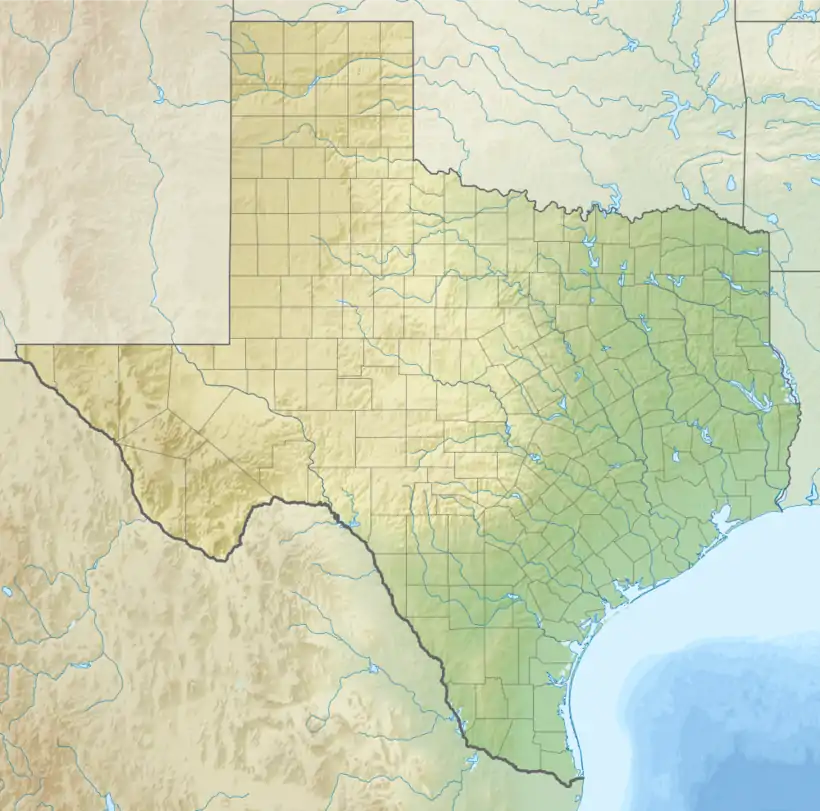Cherry Canyon Formation
The Cherry Canyon Formation is a geologic formation found in the Delaware Basin of southeastern New Mexico and western Texas. It contains fossils characteristic of the Guadalupian Age of the Permian Period.[1]
| Cherry Canyon Formation Stratigraphic range: Roadian-Wordian ~272–266 Ma | |
|---|---|
| Type | Geological formation |
| Unit of | Delaware Mountain Group |
| Sub-units | Getaway, South Wells, and Manzanita Members |
| Underlies | Bell Canyon Formation |
| Overlies | Brushy Canyon Formation |
| Thickness | 400 m (1,300 ft) |
| Lithology | |
| Primary | Sandstone, siltstone |
| Other | Limestone |
| Location | |
| Coordinates | 31.899°N 104.780°W |
| Approximate paleocoordinates | 3.7°N 34.1°W |
| Region | New Mexico, Texas |
| Country | |
| Extent | Guadalupe and Delaware Mountains |
| Type section | |
| Named for | Cherry Canyon |
| Named by | DeFord and Lloyd |
| Year defined | 1940 |
 Cherry Canyon Formation (the United States)  Cherry Canyon Formation (Texas) | |
Description
The formation consists mostly of cyclic marine sandstone and siltstone, but with interfingering tongues of gray limestone (the Getaway, South Wells,[2] and Manzanita Members). These extend from the Goat Seep reef, an earlier and much smaller precursor to the Capitan reef, into what was then deep, anoxic water of the Permian Basin. A lower tongue of the formation extends across the basin margin to grade into the nearby San Andres Formation. Maximum thickness of the Cherry Canyon Formation is 400 meters (1,300 ft). The formation rests on the Brushy Canyon Formation, but the lower tongue fills a few deep paleochannels that cut down through the Brushy Canyon and the underlying Cutoff Formation into the Victorio Peak Formation.[3] A hiatus in deposition, marking a substantial drop in sea level, separates the Cherry Canyon Formation from the overlying Bell Canyon Formation.[4]
The Getaway Member contains carbonate debris flow beds. All three carbonate members grade into sandstone channel deposits deeper in the basin.[3]
Fossils
The formation contain abundant fish fossils, such as sharks' teeth, preserved within small phosphatic nodules.[5]
History of investigation
The unit was first designated as a formation by DeFord and Lloyd in 1940, who raised the Delaware Mountain Formation to group rank and designed its previously informal members as formations.[6][7]
Footnotes
- Kues and Giles 2004, p.100
- King 1948, p.36
- Kues and Giles 2004, p.124
- Kues and Giles 2004, p.126
- "Guadalupe Mountains National Park," Hunt, Santucci, and Kenworthy (2006); page 64.
- DeFord and Lloyd 1940
- King 1942
Bibliography
- DeFord, Ronald K.; Lloyd, E. Russell (1940). "West Texas-New Mexico Symposium: Part I Editorial Introduction". AAPG Bulletin. 24. doi:10.1306/3D933188-16B1-11D7-8645000102C1865D.
- Hunt, ReBecca K., Vincent L. Santucci and Jason Kenworthy. 2006. "A preliminary inventory of fossil fish from National Park Service units." in S.G. Lucas, J.A. Spielmann, P.M. Hester, J.P. Kenworthy, and V.L. Santucci (ed.s), Fossils from Federal Lands. New Mexico Museum of Natural History and Science Bulletin 34, pp. 63–69
- King, Philip B. (1948). "Geology of the Southern Guadalupe Mountains, Texas". U.S. Geological Survey Professional Paper. 215: 36. doi:10.3133/pp215.
- Kues, B.S.; Giles, K.A. (2004). "The late Paleozoic Ancestral Rocky Mountain system in New Mexico". In Mack, G.H.; Giles, K.A. (eds.). The geology of New Mexico. A geologic history: New Mexico Geological Society Special Volume 11. pp. 95–136. ISBN 9781585460106.